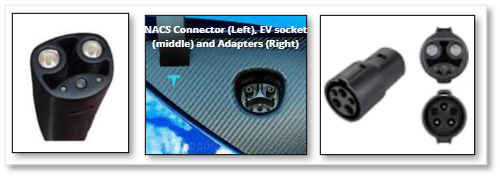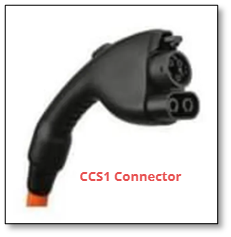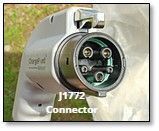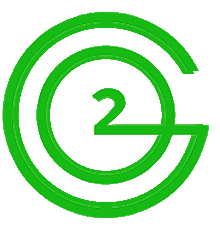Notice: EV Charging Standards Changing
The North American Charging Standard (NACS, formerly called the Tesla Supercharger) is making strides to become the new standard for Electric Vehicle connections for charging. Tesla has used the NACS since 2012. The NACS connectors allow for Level 2 AC charging up to 48 Amps (11.5 kilowatts) and DC Fast Charging up to 250 kW.
NACS Connections

Current US Charging Connections




- For Level 1 (120 Volt AC) and Level 2 (208/240 Volt AC), the SAE J1772 Type 1 standard is used (Figure 2) and has been in use since 2001. A similar standard is used in Europe, called Type 2.
- For DC Fast Charging, a different SAE standard connector is used, called the US Combined Charging Standard or CCS1 for connecting the EV charger to the vehicle for charging. This connector started first being used around 2015. The Level 1 and 2 connector is mechanically part of the CCS connector, allowing both the CCS1 and the J1772 Level 1 & 2 connections (hence “Combined”, or “Combo”). A similar standard called CCS2 is used in Europe.
- For Level 2 and DCFC for Japanese EV Manufacturers, CHAdeMO is the standard for both the EVSE and the EV. Nissan was the first successful EV, starting with CHAdeMO in 2011. CHAdeMO is likely going away as a standard in the US.

New Future Standards and EV Charging Practices
All (non-Tesla) US EVs to date come equipped with the J1772 and/or CCS socket connections and all Teslas to date come with the NACS connectors. In December 2022, Aptera Motors became an early adopter of NACS on their EVs. [i] In May 2023, Ford and in June 2023, GM and Rivian announced they will adopt the NACS connectors in future models, perhaps starting in 2024 or later. [ii]. [iii] A good possibility exists that NACS will displace all the J1772 and CCS standards over the next few years for all new North American EVs, and therefore the EVSEs. The jury is still out on the details, the timing and the costs to consumers, but when considering adding EV charging stations and purchasing EVs, market participants should be aware of this. The good news is that with one standard, all EVs can charge at all EV charging stations, at some point in the future.[iv] Also, so far this appears to be a simple technical change for EV and EVSE owners.

Endnotes
[i]
“Aptera Motors Confirms Use Of Tesla's NACS Charging Connector”, Mark Kane, December 1, 2022,
https://insideevs.com/news/624548/aptera-confirms-tesla-nacs-charging-connector/
[ii]
“Future Ford EVs Will Be Equipped With Tesla Charging Port”, Eric Loveday, May 25, 2023, InsideEVs Webpage,
https://insideevs.com/news/669212/ford-switch-tesla-ncas-chargign-connector/
[iii]
“Rivian to Implement Tesla Charging Port on R1s and RT”, Inside EVs Website, Iulian Dnistran, June 20, 2023
https://insideevs.com/news/672904/rivian-tesla-charging-port/
[iv] “The Advantages of The Two Charging Standards – To Tesla, or not to Tesla. That is the question” EV Charging Stations Website, https://evchargingstations.com/guides/two-charging-standards/ agraph

